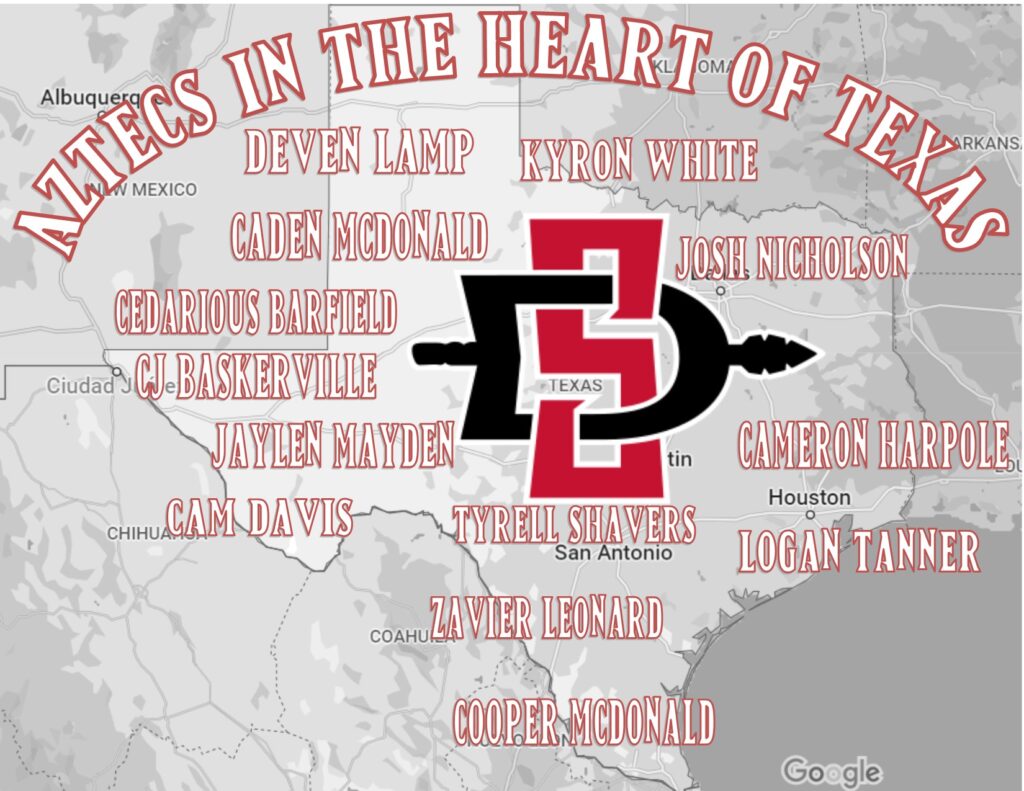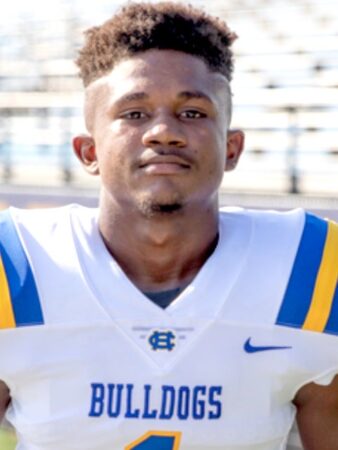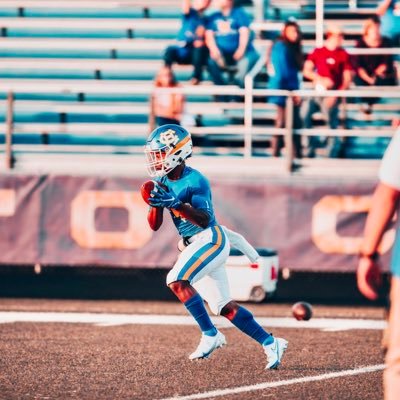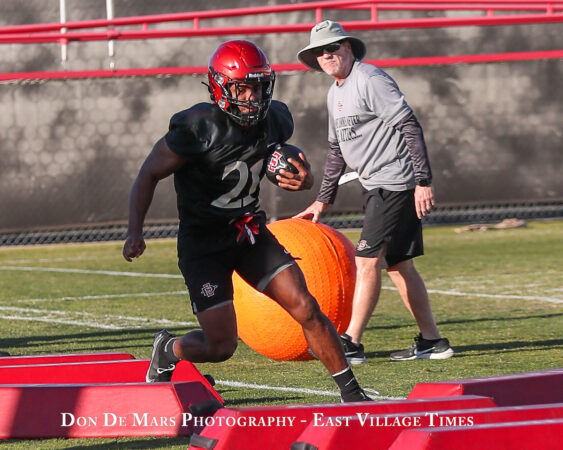Aztecs in the Heart of Texas


Snapdragon Stadium is scheduled to open in less than four months. The impact of SDSU’s new home on the football program is expected to be pronounced. Under the terms of the lease of the old stadium, the university paid $1.1 million for rent, all the parking and concessions revenue, and one dollar for every ticket sold to the City of San Diego. SDSU also covered the vast majority of the game-day operating costs.
Recouping that money alone would be a boon to the athletic budget. Add in the increased revenue from higher ticket prices and the expected boost in attendance, and the Aztecs should reach a whole new tier financially.
What this added money will do for the program is of great interest and speculation among Aztec supporters. The revenue’s impact will not be fully realized until budgets within the athletic department move from speculation to actualization in the coming years.
One area where signs of a change are already visible, however, is in recruiting. SDSU is casting a wider net as it looks to find the next Aztec Warriors than ever before.

Mike Goff has been given a new recruiting area in Colorado. There are currently no players from the Centennial State on SDSU’s roster. Justin Ena is hoping to give the Aztecs a bigger presence in Utah. Liu Aumavae is the only Montezuman from the Bee Hive State.
Perhaps, the greatest example of the program’s recruiting expansion is the Aztecs’ growing presence in Texas. Aside from California, no state has a bigger impact on SDSU’s roster than the Lone Star State. More Texans play at SDSU than any other FBS school in the Sunshine State. Stanford (12), USC (10), CAL (8), UCLA (8), Fresno State (2), and San Jose State (0) all have fewer former Texas prep stars on their rosters than SDSU (13). Ten years ago, the Aztecs roster contained only three.
Cementing the pipeline that brings so many Texas players to San Diego is the success athletes have had when they head west for college. Two of SDSU’s three starting safeties- CJ Baskerville, and Cedarious Barfield – are from Texas. Tyrell Shavers, Cooper, and Caden McDonald, and Zavier Leonard are all atop the post-spring two-deep. Kyron White is a top backup safety. Jalen Mayden is third on the depth chart at Aztec safety after a position change. Deven Lamp is third as well, following an injury that held him out of Spring Camp. Underclassmen Cam Davis, Josh Nicholson, Cameron Harpole, and Logan Tanner have all drawn praise from the coaching staff and appear to have bright futures on the Mesa.
The importance of these players’ success cannot be overstated, as the staff is looking for the next wave of Texans in the class of 2023. Football is king in the Lone Star State. Unlike most places, when a prep athlete in Texas excels on the gridiron, they become stars, and their college careers are followed with great interest by their entire city. Players all over the state have taken notice of the 13 Aztecs from Texas excelling in America’s Finest City.
“It makes the situation very attractive,” Tyson Berry from Chapel Hill High School in Tyler, Texas, said when asked about the success Texans are having with the Aztecs. “Just a testament to Texas High School Football and the level of dedication it takes to play at a high level.”
San Diego State offers WR Tyson Berry
Berry is the perfect case study for the headway SDSU has made in the Lone Star State. The rising senior is a multisport athlete, running a 12:07 100m dash as a sophomore, starting as the point guard on the basketball team, and excelling on the gridiron as a slot receiver. Chapel Hill utilized Berry in a similar fashion as Junipero Serra High School used incoming SDSU freshman Hassan Mahasin.

A varsity player since his freshman season, Berry is a quick-twitch athlete and a threat to take it the distance every time he touches the ball. He was very good as an underclassman, with a combined 128 touches from scrimmage – 57 rushes and 69 receptions – in his first two seasons. He accumulated 1,155 yards (9.02 yards per touch) and 13 touchdowns.
During his junior campaign, Berry became a playmaker. In half the touches – 18 rushes and 46 receptions – he nearly matched the same number of yards and touchdowns, finishing with 1,075 and 12 scores. Berry had an eye-popping 12.5 yards per carry and 18.5 average per reception this past season.
More importantly, his teams started winning. Following a run in the state playoffs in 2013, Chapel Hill was 17-49 over the next six seasons, including a 2-8 mark in Berry’s freshman season. In the last two years, the Bulldogs went 20-8. This past season, they lost in the state semifinal 38-35. It has been an amazing turnaround.
“Explosive. Human Joystick,” Chapell Hill Head Coach Jeff Riordan told EVT when asked to describe Berry. “Plays the game at another level. Tyreek Hill and Marshall Faulk similarities. … Tyson has played 38 varsity football games. We had to count on several freshmen that first season. They gained valuable experience and learned how to win. He was monumental in the culture change in Chapel Hill.”
The Aztecs’ interest in Berry is not surprising. SDSU features players with his skill set on jet or fly sweeps, in the screen game, as a sure-handed receiver over the middle or as a deep threat. What makes Berry’s recruitment special is the Aztecs had the resources and relationships to be the dynamic receiver’s first offer.
Blessed to receive my 1st Offer from @AztecFB only Means Stay Humble and GRIND❗️❗️Thank you @CoachCooperSDSU for believing in me and my Skillset as a Player and as a Young Man!
Special S/O to @coachriordan , @johnsonboi24 for PUSHING me! #OHANA pic.twitter.com/bGAssoi1a1
— Tyson Berry (@YoungBull2023) April 18, 2022
One of Brady Hoke’s first decisions when he was rehired as head coach was to add four new staff members to the player personal department. With more coaches scouring the limitless amount of highlight and game film, it allows SDSU to scout and offer more prep athletes. The expected increase in the recruiting budgets over the next couple of years should allow the program to add even more recruiting analysts to the staff.
“Not often,” Riordan responded when asked how frequently a university outside Texas is the first to see Division One talent in a local player. “That was huge to see an out-of-state school recognize and evaluate a great ballplayer. He will be an asset to any level and any school he decides to suit up with. His versatility and ability to play anywhere is a huge asset.”
“It has always been a dream of mine to play football out of state,” Berry, who has since added a pair of offers from Texas universities, added. “Once SDSU offered me, I was very surprised but humbled to be offered by such a prestigious university.”
SDSU’s expanding recruiting footprint

SDSU’s coaching staff is clear about the values of their program and the types of players they are looking for in recruits. SDSU makes great demands of its athletes off the field in order to maximize their growth on it. Only players who are tough, love football, work hard, and have high personal character find success as Aztecs. This “old school” approach has fallen out of favor in some circles, particularly in the West, but it continues to be a way of life in the South.
“That is what Texas is all about,” Berry explained when asked about the four values at SDSU. “I grew up with my uncle, who is also a coach. He has been tough on me and instilled discipline since I was nine years old. Also, I have to give a shout-out to Coach Riordan for adding to that discipline and helping me grow in ways I couldn’t have dreamed of. The SDSU culture and myself will mix well.”
The Aztecs’ inroads into Texas are due primarily to Associate Head Coach/Running Back Coach Jeff Horton. A native of Arlington, Texas, Horton has developed deep ties to the coaching community in the Dallas/Fort Worth (DFW) Metropolitan Area. 11 of the 13 Aztecs from the state of Texas are from DFW. Senior Cedarious Barfield (El Paso) and freshman Logan Tanner (Houston) are the only players from other parts of the state.
“Coach Horton is a very respected man in Texas High School Football,” Berry said. “He is known for getting the best out of his players and developing young men like myself.”

Building off the foothold created by coach Horton, the continued success of Texans in the program, and the shared football culture, SDSU is broadening its recruiting efforts in the state. DFW continues to be an emphasis, but over the past month, the Aztecs have offered players all over the state.
They are recruiting Marquise Collins in College Station and Lorenzo Diggs from Pflugerville, a suburb of Austin. Last week, Kyle Hoke was in Houston offering defensive backs like four-star cornerback TayShawn Wilson. Berry plays in Tyler, Texas, about two hours from Horton’s hometown in Arlington.
“Texas is and will always be loaded with prospects,” Riordan explained. “Texas is recruited by schools all over the nation. We are very blessed with great talent, great support, and great coaches in Texas. Our kids are usually ready for the grind of college ball and prepared with football IQ. Not surprising to see Texas kids excel in San Diego or anywhere in the nation.”
[wpedon id=”49075″ align=”right”]
According to 247 sports, SDSU has extended 26 scholarship offers to players in Texas. That number is more than double any other state outside of California. The list continues to grow weekly.
As Snapdragon adds more resources to their efforts, expect SDSU to continue building off the foundation built by coach Horton. Look for the staff to leverage the success of the players currently on the team by finding more Aztecs in the heart of Texas.
My earliest sport’s memory involve tailgating at the Murph, running down the circular exit ramps, and seeing the Padres, Chargers and Aztecs play. As a second generation Aztec, I am passionate about all things SDSU. Other interests include raising my four children, being a great husband and teaching high school.
Nice work keep writing about Texas Aztecs.